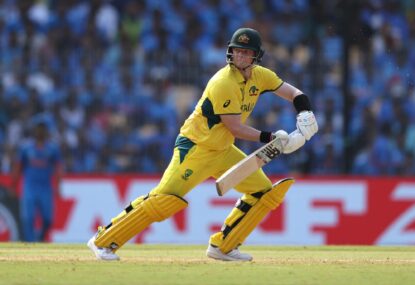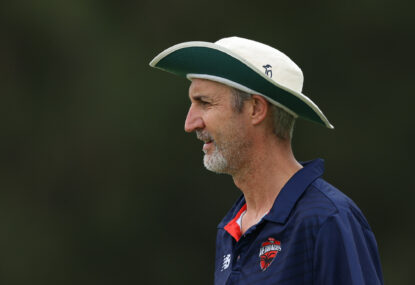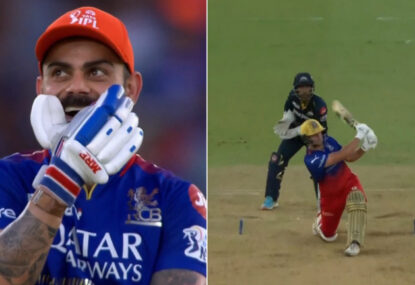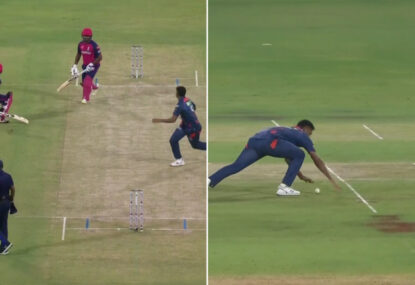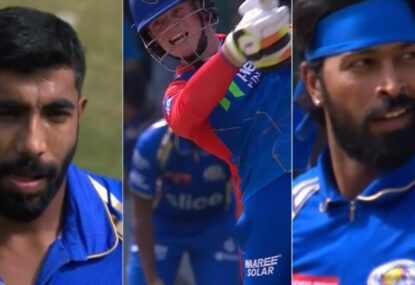When one is confronted with a brick wall and is given the simple direction of getting to the other side, several options spring to mind immediately.
The first, and most obvious for the thick-headed among us, is to use our best asset: our thick head.
Surely, by battering the wall, three bricks deep, with our skull for long enough we could just batter down the wall. Several mild concussions later we could simply stroll over the other side, dust off our hands and be done.
Other options, of course, relate to things like walking around the wall, going over the wall, and using loop, spin, drift and guile to coax the wall from its crease so our wicketkeeper can whip the bails off and the wall must begin the long trudge back to the pavilion.
These are options that don’t come to mind so readily as atrium-breaking headbuttery, but are all options worth exploring nonetheless.
The point of this horrifically mixed analogy, if you hadn’t gathered it already, is that the Aussie cricket selectors got our strategy brilliantly and shockingly wrong for the first Test match against India.
So despite our insistence that pace is our strong point and spin our weakness, both in batting and in bowling, sometimes you can’t fight the conditions.
Nathan Lyon, despite going past two hundred, and not in a good way, at least had three poles to show for it.
James Pattinson bucked the trend, but we have to say now that we are looking at a kid who is going to be a serious stalwart in the Aussie team for a long time. I’m going to call it early on Pattinson: he will be one of the greats.
Not only is his action extremely smooth and his approach to the crease powerful yet stable, but he has that trait that is so revered in the best quicks: he simply hates batsmen.
I’ve said it before, and I’ll say it again; he hates their essence, their soul, their very reason for existence. As such, he will take wickets on the most docile of tracks, simply because every ball is bowled either with the intention of taking a wicket, or building up to the ball that will take the wicket.
And these two are our only locks for the next Test’s attack.
Right now it is the selectors job to look at the other two quicks and figure out which, if any, should keep their spot. The options are many, but realistically not as plentiful as we would like.
Doherty must play the next game, despite the Indian lineup being bereft of left-handers. He will add variety, and hopefully the tracks will lend him the spin that he doesn’t get with the white ball in Australia.
Somewhat like Ashwin, Doherty concentrates on sidespin, and hopefully he will profit from this in the conditions.
If he doesn’t, we know that he has another gear; a run-saving gear. At the very least this will be useful when chaps like Dhoni decide to mount the slogging horse.
What does this mean for Siddle and Starc? Realistically, at least one of them has to make way.
Henriques, rightly or wrongly, commands selection for the next game on the strength of his batting alone.
While he didn’t prove he could do the job with the ball that Shane Watson did in 2010, he did nab a wicket later in the innings and looked as much of a threat as Siddle or Starc.
Another option is to bring back our most effective bowler from the 2010 series in India, Mitchell Johnson.
Johnson has a good bouncer and is genuinely fast, things that Pattinson profited from in the Chennai Test. He can also reverse swing it away from righties from around the wicket, which is perhaps his most dangerous weapon.
In my view, gambling on Johnson for some menace and wicket taking potential, and Doherty and Henriques for some sanity, might just be the way to play these conditions.
It’s certainly better than banging the ball in on a length to be picked off for singles to deep point.
And far better than bashing one’s head against a brick wall.
Follow Paddy on Twitter @WarmingthePine





























































































